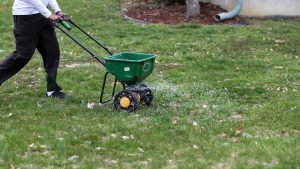Despite warm weather, warm season turf grasses still aren’t actively growing. Applying fertilizer now — in March — is premature.
The San Antonio River is dyed shamrock green every St. Patrick’s Day, but the color quickly washes out, returning the river to its normal muddy color.
And that’s a good thing since most of the year excessively green rivers and other bodies of water wouldn’t be a sign of a healthy ecosystem. Instead, they often indicate an excessive nutrient load — meaning fertilizer, phosphorus and nitrogen have washed into the water, causing blooms of algae and duckweed. Eww.
In fact, the St. Patrick’s Day dye job serves as a good reminder that with San Antonio still in exceptional drought, and the Edwards Aquifer 30 feet below the drought triggers, a green lawn is at least several good-luck rainbows away these days. And it’s much too early to apply fertilizer to the brown lawn or landscape.
Despite warm (and windy) weather, warm season turf grasses (Bermuda, zoysia and St. Augustine) still aren’t actively growing, so applying fertilizer now is premature.
- You want to wait until you’ve mowed the summer turf grass at least two times before adding nutrients — meaning it must be growing. That’s April at the earliest. The only grass long enough to cut right now is still winter-weed rescue grass.
- Even for the earliest flowering woody perennials, fertilizer shouldn’t be provided until the leaves develop fully (usually in April or early May.)

So if the sight of colorful bags of fertilizer at the big box store is striking a “green with envy” nerve and making you wish your own landscape was just as vibrant, it’s worth remembering that fertilizer is best applied when the landscape is actively growing later in spring, if at all. Definitely not when it’s still barely awakening from its brown winter dormancy.
The benefit of waiting until the right time? You save your time and money for something that may actually help your landscape and not just run off into local creeks and rivers. Remember, any child drawing a river would probably rather start with a blue crayon, not a green one.


